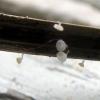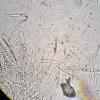
25-11-2025 14:24
Thomas Læssøehttps://svampe.databasen.org/observations/10490522

25-11-2025 11:03
Mick PeerdemanHi all,One of my earliest microscopy attempts, so

24-11-2025 15:23
Arnold BüschlenHallo, auf einer offenen Kiesfläche am Rande ein

23-11-2025 11:16
Bohan JiaHi, I found small discs growing on dead stem of

21-11-2025 10:56
 Christopher Engelhardt
Christopher Engelhardt
Very small (~0,5 mm) white ascos, found yesterday
White oddity
Marja Pennanen,
27-05-2010 10:41
Marja Pennanen,
27-05-2010 10:49
Re:White oddity
This showed some facilities new to me in microscope.
I've never seen such paraphyses or hairs- meaning so big droplets.
The spores are 6-12x1-2, asci 33-40x4-5.
Lanceolate paraphyses are 4-5 micrometers wide and exceed the asci about 10-15 micrometers and have lots of droplets.
Hairs are 35-40x3-5 and they have droplets, too. Except at the stipe, where they are smaller, but can branch.
Strange, actually I have no idea even of the genus...
Marja
I've never seen such paraphyses or hairs- meaning so big droplets.
The spores are 6-12x1-2, asci 33-40x4-5.
Lanceolate paraphyses are 4-5 micrometers wide and exceed the asci about 10-15 micrometers and have lots of droplets.
Hairs are 35-40x3-5 and they have droplets, too. Except at the stipe, where they are smaller, but can branch.
Strange, actually I have no idea even of the genus...
Marja
Enrique Rubio,
27-05-2010 10:51
Re:White oddity
Its a Lachnum (Dasyscyphus) species, probably L. pudicellum
Enrique
Enrique
Hans-Otto Baral,
27-05-2010 10:56

Re:White oddity
Yes, I agree. The hairs are surely warted. The droplets inside and in the paraphyses are VBs (vacuolar bodies), they are responsible for the colour change to red-brown in the dead state. Such a fungus may look deep brown when dry. If you add KOH these droplets disappear.
Zotto
Zotto
Marja Pennanen,
27-05-2010 11:17
Re:White oddity
Hello,
thanks. One of the synonyms seems to be L. tenuissimum and I've allready found that.
With another microscope things seems different ;)
Marja
thanks. One of the synonyms seems to be L. tenuissimum and I've allready found that.
With another microscope things seems different ;)
Marja



